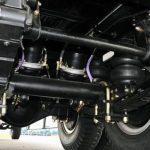The automotive aftermarket, a dynamic and evolving sector, has witnessed a remarkable transformation in recent years, primarily driven by the advent of digitization. This change is not just a fleeting trend but a fundamental shift in how the industry operates, offering new opportunities for businesses like those specializing in leaf springs.
Key Changes Brought by Digitization
The global pandemic and rapid technological evolution have accelerated the shift to digital solutions in the automotive aftermarket. This shift has been necessary for businesses to meet new demands and adapt to changing customer behaviors. Digitization in this context refers to more than just implementing digital tools; it involves a fundamental change in business processes and models.
First, it’s revolutionizing supply chain management, making it more automated and efficient. This means quicker, more reliable access to automotive parts and services. Next, e-commerce has emerged as a game-changer, offering customers the convenience of shopping for automotive parts with just a few clicks. This shift to online platforms is not just about convenience; it’s about providing a wider range of choices and competitive pricing.


Moreover, the power of AI and data analytics is being harnessed to understand customer preferences better, leading to more personalized services and products. This data-driven approach helps businesses anticipate customer needs and stay ahead of market trends. In the realm of vehicle maintenance, the introduction of connected vehicles and IoT technology has been a major leap forward. This technology enables predictive maintenance, ensuring vehicles are serviced before issues arise, thereby enhancing safety and extending vehicle life.
Challenges and Opportunities
This digital shift presents both challenges and opportunities. Established players must adapt to integrate new technologies and business models or risk obsolescence. The focus is increasingly on service and customer orientation, with market participants who understand and cater to customer needs gaining a competitive edge. The future of the automotive aftermarket hinges on the ability of players to engage more effectively with customers and adopt a more service-oriented approach, ensuring they remain relevant in this rapidly evolving digital landscape.


Despite the clear advantages, the transition to digital has not been without challenges. The industry is fragmented, with a mix of large players and small, family-owned businesses. While larger companies have been able to invest heavily in digitization, smaller players often see it as a costly and daunting endeavor.
The Future of Digitization in the Automotive Aftermarket
The future of digitization in the automotive aftermarket is poised to redefine the industry, bringing unprecedented levels of efficiency and innovation. This upcoming era will leverage advanced digital technologies to enhance every aspect of the aftermarket experience, from diagnostics to customer service.


- Digital Integration in Services: The aftermarket is evolving beyond traditional repair services. Expect a surge in digital platforms offering everything from online appointment scheduling to real-time service updates. This digital integration enhances customer experience and operational efficiency.
- Data-Driven Customization: The use of big data and analytics will revolutionize how aftermarket services are offered. By analyzing customer behavior and vehicle data, companies can provide tailored maintenance suggestions, improving service relevance and customer satisfaction.
- Emerging Tech in Vehicle Maintenance: With the rise of electric and autonomous vehicles, the aftermarket will see a shift in focus. Services will increasingly cater to high-tech components like battery systems and software updates, requiring new skills and tools.
- Enhanced Customer Interaction: Digitization is set to transform customer interactions. From AI-powered chatbots providing instant assistance to apps that track service history, the focus will be on making every touchpoint convenient and informative.
- Sustainability Through Technology: Digitization also paves the way for more sustainable practices in the aftermarket. Digital tools can optimize resource use, reduce waste, and promote recycling, aligning with the growing demand for eco-friendly services.
Conclusion
The digitization of the automotive aftermarket has not just changed the industry; it has revolutionized it. Companies that embrace this change, investing in sustainable digital solutions and fostering a culture of innovation and adaptability, are well-positioned to succeed in this new era. As we move forward, the ability to anticipate and respond to evolving market needs will be crucial for continued growth and success in the automotive aftermarket.





